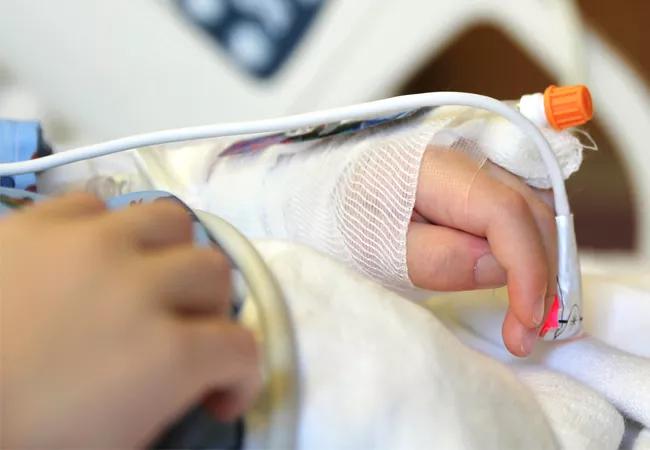Laryngeal mask airway ventilation offers many benefits

Some of the best medical techniques are born out of necessity. In 2016, Paul Krakovitz, MD, Section Head of Pediatric Otolaryngology at Cleveland Clinic, needed to perform an airway procedure on a pediatric patient in an outpatient setting where the anesthesia team was not facile in spontaneous ventilation or jet ventilation. He knew that he could use laryngeal mask airway (LMA) ventilation. Following the success of this procedure, he and a team from Cleveland Clinic’s Otolaryngology Department set out to research the use of LMA ventilation during pediatric airway surgery.
Advertisement
Cleveland Clinic is a non-profit academic medical center. Advertising on our site helps support our mission. We do not endorse non-Cleveland Clinic products or services. Policy
With endoscopic airway surgery the mainstay for evaluation and treatment of many airway pathologies, several strategies have been used to maintain oxygenation and ventilation during intervention. These include controlled mechanical ventilation using a small endotracheal tube, apneic anesthesia with intermittent ventilation, jet ventilation and spontaneous ventilation.1,2,3
Each strategy has its drawbacks. Intubation, even with a small endotracheal tube, limits visualization and access to the larynx.2,3 Alternatively, apneic anesthesia with intermittent ventilation, while providing excellent visualization, does so for only short periods of time and subjects the patient to multiple intubations.2,3,4 Jet ventilation offers exposure and uninterrupted ventilation,3,5 but carries with it disadvantages of jet-induced vocal cord movement, barotrauma, and distal propagation of debris or viral particles.2,3,5 As a result, spontaneous ventilation with supraglottic delivery of oxygen or anesthetic gases has become the technique of choice at many institutions.1,3,6
Delivering oxygen flow through or around a rigid laryngoscope has remained a challenge. Previously described techniques include insufflation through lateral ports incorporated in the laryngoscope body.1,3 Additionally, placement of an endotracheal tubes in the supraglottis or laryngopharynx can facilitate for oxygen flow closer to the laryngeal introitus6; however, may be cumbersome or require a hand to stabilize.
LMA ventilation is widely used as an alternative to endotracheal intubation in the pediatric population and results in fewer post-anesthetic complications compared to endotracheal intubation.8 The Cleveland Clinic team was able to incorporate the LMA as a hands-free ventilating device that allows unobstructed access to the supraglottis, larynx and trachea during endoscopic laryngotracheal surgery.
Advertisement
Once in position, the ventilating device requires no additional hand for stabilization and does not occupy space within the laryngoscope needed for instrumentation. LMA ventilation has the added benefit of being a commonly used device in anesthesia with decreased post-anesthetic risks compared to endotracheal intubation.8
“Our technique using an LMA ventilation device positioned posterosuperiorly to the larynx during endoscopy, which allows for continual delivery of oxygen or anesthetic gases close to the laryngeal introitus while providing an unobstructed view of the larynx,” explains resident Blake Smith, MD, from the Otolaryngology research team. “Based on the cases we’ve done, LMA ventilation has been more comfortable for the patient and reduced risk for complications while it allows for an outstanding view of the airway.”
Nine patients have undergone laryngotracheal surgery using the described ventilation technique. Patients’ ages have ranged from 3 months to 22 years old at the time of surgery, with an average age of 11. Operations performed included three injection medializations, two excisions of respiratory papilloma, two supraglottoplasties, a subglottic dilation, airway foreign body removal, and a surveillance bronchoscopy. Only one patient was intubated intermittently for airway sizing with an endotracheal tube. The average length of surgery was 27.6 +/- 15.5 minutes. Only two patients had documented SaO2 less than 90 percent and these were less than one minute in duration.
Advertisement
The research concluded that placement of an LMA prior to suspension microlaryngoscopy provides a safe and effective method for hands-free ventilation during pediatric endoscopic laryngotracheal surgery while allowing for an unobstructed view of the larynx. This approach avoids interruptions in surgery for intermittent intubation and offers an alternative to jet ventilation, mitigating the risk of barotrauma. Further, the LMA gives additional safety for maintaining the airway in an emergent situation.
References:
Advertisement
Advertisement
Advertisement

Case study illustrates the potential of a dual-subspecialist approach

Evidence-based recommendations for balancing cancer control with quality of life

Study shows no negative impact for individuals with better contralateral ear performance

HNS device offers new solution for those struggling with CPAP

Patient with cerebral palsy undergoes life-saving tumor resection

Specialists are increasingly relying on otolaryngologists for evaluation and treatment of the complex condition

Detailed surgical process uncovers extensive middle ear damage causing severe pain and pressure.

Despite advancements in the specialty, patient-centered care needs to remain a priority